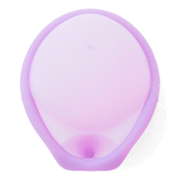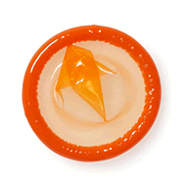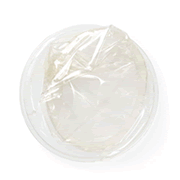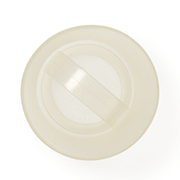How to use barrier methods like a pro
They’re hormone-free, prevent sperm from meeting egg, and work best if you use ‘em right.

What do condoms, internal (a.k.a. female) condoms, the diaphragm, the cervical cap, and the sponge all have in common? They all literally put a barrier between sperm and egg. These barrier methods aren’t as effective as many other methods, but they’re generally easy to get, cheap (or free) and can be doubled up with other methods. Oh, and they work best if you use them like a pro.
Condoms
The dual protection wonders of the world, condoms bravely protect their users from both pregnancy and sexually transmitted infections (STIs). And there are SO many different kinds to choose from.
How do I get condoms? You may be able to get free condoms at health centers, or you can buy them at drugstores, gas stations, and supermarkets. You can also buy condoms online—some condom websites sell variety packs, so you can try different kinds.
How much do condoms cost? Condoms are usually pretty cheap, between $0.25 and $2, or you may be able to find them for free.
How do I use condoms? For condoms to work best for pregnancy and/or STI prevention, you have to start using them before the penis touches any internal parts—mouth, vagina, or butt. Also, be warned that there is one type of condom that does not protect against STIs, known as “lambskin” or “natural skin” condoms. Here’s more on how to put on a male condom and how to insert a female (a.k.a. internal) condom.
When do I use condoms? Male condoms are downright time-sensitive—they need to go on right before sex and come off right afterward. Internal condoms can be inserted up to 8 hours before sex and should be removed right afterward. Each condom is good for exactly one romp in the hay. Break out a fresh one for the sequel.
Should I use spermicide? You don’t need to add vaginal spermicide for condoms to work, but you can if you want to. Any type of spermicide will work—gel, film or suppository. You can also add whatever lube you prefer. (There’s one important exception: if you’re using latex condoms, avoid using oil, petroleum jelly, or any other oil-based lubes. Those types of lube can make the condom break.)
Pro tip: If you’re using a male condom, put a drop of lube on the head of the penis before putting the condom on. You don’t want so much that it makes the condom slip around—just enough to increase the contact between the skin of the glans and condom.
The diaphragm
The Ortho Flex diaphragm is now off the U.S. market, but the Milex wide seal diaphragm is a similar alternative. Also, the Caya diaphragm is officially available in the U.S. now.
How do I get a diaphragm? The Milex diaphragm comes in different sizes and a health care provider will need to do an exam to make sure it will fit just right around your cervix. Caya is one-size-fits-most, so you don’t need a pelvic exam or fitting to get one. Providers and pharmacies may not have these diaphragms in stock, so if you get a prescription for one, your provider or pharmacy may need to order it.
How much does the diaphragm cost? Both the Milex and Caya diaphragms can cost up to around $90 if they’re not covered by your insurance. Because they are considered devices rather than drugs, some people aren’t able to get insurance coverage, so call your plan to find out.
How do I use the diaphragm? You insert the diaphragm to cover your cervix. Both Milex and Caya can last for up to two years.
When do I use the diaphragm? If you prefer not interrupting the foreplay flow to deal with birth control, you can put a diaphragm in place up to six hours before sex. After sex, keep the diaphragm in place for at least six hours, and up to 24. That gives the spermicide time to knock out all the sperm. If you have sex a second time with a diaphragm already in place, it’s handy to have some Gynol II in applicator tubes. The tube makes it easier to put spermicide way up in the vagina near the diaphragm.
Should I use spermicide? Yes. Part of how diaphragms work to prevent pregnancy is spermicide. Use spermicidal gel that you can put inside the cup of the diaphragm and around the rim. The most common brand of spermicidal gel in the U.S. is Gynol II, with the active ingredient nonoxynol 9. If you’re interested in checking out a new spermicide, there’s a new alternative called Cayagel, which is sold with the Caya diaphragm in Canada and Europe. Its active ingredient is lactic acid. It’s not approved in the U.S. yet (which means the FDA hasn’t vetted it for effectiveness), but the devoted may be able to purchase it online.
Pro tip: Practice putting in the diaphragm and taking it out with no sex involved. You have to wear it for at least six hours after sex, so give yourself some time to learn how to place it so it’s comfortable. If a diaphragm fits right, you shouldn’t be able to feel it any more than you feel a tampon.
The cervical cap
The cervical cap in the U.S. is called the FemCap. We’re gonna be straight with you here—it’s not very commonly used these days.
How do I get a cervical cap? It comes in three sizes, and a provider prescribes one based on your medical history, no pelvic exam or fitting required. You can fill the prescription at a pharmacy, but call ahead since they may need to order it.
How much does the cervical cap cost? The cervical cap costs $89 and you’re supposed to get a new one every year or two. It may or may not be covered by your insurance.
How do I use the cervical cap? Like the diaphragm, the cap requires spermicidal gel. If you have sex a second time, use more spermicide. Here’s more about how to insert and remove the cervical cap.
When do I use the cervical cap? According to the FemCap website, it can be put in place up to 40 hours before sex, and should be left in place for at least six hours after sex. It can stay in up to 48 hours.
The sponge
The sponge is a soft disk with a dimple in one side. To use it, you wet it a bit and then put it near the top of your vagina with the dimple facing the cervix. The sponge has the spermicide nonoxynyl-9 inside it, and you activate it when you wet the sponge. You don’t need to add more spermicide.
How do I get the sponge? Like condoms, you can buy the sponge at a drugstore or online without a prescription. Sponges come in boxes of three.
How much does the sponge cost? Usually sponges cost about $4-6 each.
How do I use the sponge? Wet it, insert it, and you’re good to go.
When do I use the sponge? You can put the sponge in place up to 24 hours before sex and should leave it in for at least six hours after sex. (Make sure not to leave it in for more than 30 hours though!) Unlike the diaphragm and cap, you can have sex more than once while the sponge is in place without taking any special precautions.
Can I use lube with barrier methods?
The latest research on lubes shows that over two-thirds of U.S. women have tried it at least once, for fun, to make sex more comfortable, or to enhance foreplay. In general, water-based lubes and barriers are a good mix. If you’re using a barrier method that requires a spermicidal gel, the spermicide may act as a lubricant, or it’s fine to add more water-based lube as needed. Add lube after you’ve gotten the barrier and spermicide in place.
Can I use barrier methods during my period?
If you use a diaphragm, cap, or sponge, it’s fine to use your method during your period, but don’t leave it in for more than 24 hours. These methods aren’t as effective as a menstrual cup at catching the flow, so if you’re putting them in place a few hours before sex, you may also want a pad or tampon. Same goes for a female condom if you put it in ahead of time. Condoms are fine to use during your period.
Can I double up barriers with other methods?
You can make barrier methods more effective for pregnancy prevention by doubling up, for instance using a barrier with a hormonal method or using a diaphragm or sponge as backup when using condoms. If part of the appeal of a barrier method is that you’re in control and there are no hormones, you might like the idea of combining a barrier method (or two) with a natural method like withdrawal (a.k.a. pulling out) or fertility awareness to prevent pregnancy. And of course, you can double up a condom with any method for STI protection. Here’s a little more information about these methods.

We never want fear of pregnancy or STIs to get in the way of great sex, so if you’re using a barrier method, make sure you use it like the stone-cold birth control genius we know you can be. And if you have questions or tips about barrier birth control, hit us up in the comments.
How do you feel about this article?

Heat up your weekends with our best sex tips and so much more.



